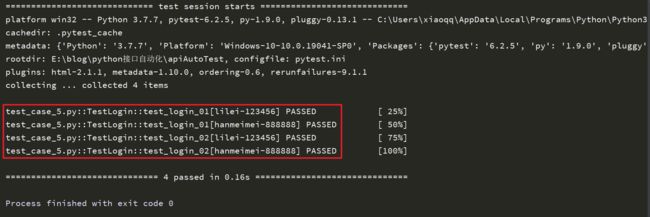前言
什么是参数化,通俗点理解就是,定义一个测试类或测试函数,可以传入不同测试用例对应的参数,从而执行多个测试用例。
例如对登录接口进行测试,假设有3条用例:正确账号正确密码登录、正确账号错误密码登录、错误账号正确密码登录,那么我们只需要定义一个登陆测试函数test_login(),然后使用这3条用例对应的参数去调用test_login()即可。
在unittest中可以使用ddt进行参数化,而pytest中也提供非常方便的参数化方式,即使用装饰器@pytest.mark.parametrize()。
一般写为pytest.mark.parametrize("argnames", argvalues),其中:
argnames为参数名称,可以是单个或多个,多个写法为"argname1, argname2, ......"argvalues为参数值,类型必须为list(单个参数时可以为元组,多个参数时必须为list,所以最好统一)
当然pytest.mark.parametrize()不止这两个参数,感兴趣的可以去查看源代码,后面我们还会讲到其中的参数ids。
示例中所请求的登陆接口信息为:
- 接口url:http://127.0.0.1:5000/login
- 请求方式:post
- 请求参数:{"username": "xxx", "password": "xxxxxx"}
- 响应信息:{"code": 1000, "msg": "登录成功", "token": "xxxxxx"}
单个参数
只需要传入一个参数时,示例如下:
# 待测试函数
def sum(a):
return a+1
# 单个参数
data = [1, 2, 3, 4]
@pytest.mark.parametrize("item", data)
def test_add(item):
actual = sum(item)
print("\n{}".format(actual))
# assert actual == 3
if __name__ == '__main__':
pytest.main()
注意,@pytest.mark.parametrize()中的第一个参数,必须以字符串的形式来标识测试函数的入参,如上述示例中,定义的测试函数test_login()中传入的参数名为item,那么@pytest.mark.parametrize()的第一个参数则为"item"。
运行结果如下:
rootdir: E:\blog\python接口自动化\apiAutoTest, configfile: pytest.ini
plugins: html-2.1.1, metadata-1.10.0, ordering-0.6, rerunfailures-9.1.1
collecting ... collected 4 items
test_case_2.py::test_add[1] PASSED [ 25%]
2
test_case_2.py::test_add[2] PASSED [ 50%]
3
test_case_2.py::test_add[3] PASSED [ 75%]
4
test_case_2.py::test_add[4] PASSED [100%]
5
============================== 4 passed in 0.02s ==============================
从结果我们可以看到,测试函数分别传入了data中的参数,总共执行了5次。
多个参数
测试用例需传入多个参数时,@pytest.mark.parametrize()的第一个参数同样是字符串, 对应用例的多个参数用逗号分隔。
示例如下:
import pytest
import requests
import json
# 列表嵌套元组
data = [("lilei", "123456"), ("hanmeimei", "888888")]
# 列表嵌套列表
# data = [["lilei", "123456"], ["hanmeimei", "888888"]]
@pytest.mark.parametrize("username, password", data)
def test_login(username, password):
headers = {"Content-Type": "application/json;charset=utf8"}
url = "http://127.0.0.1:5000/login"
_data = {
"username": username,
"password": password
}
res = requests.post(url=url, headers=headers, json=_data).text
res = json.loads(res)
assert res['code'] == 1000
if __name__ == '__main__':
pytest.main()
这里需要注意:
- 代码中
data的格式,可以是列表嵌套列表,也可以是列表嵌套元组,列表中的每个列表或元组代表一组独立的请求参数。 "username, password"不能写成 "username", "password"。
运行结果如下:
从结果中我们还可以看到每次执行传入的参数,如下划线所示部分。
这里所举示例是2个参数,传入3个或更多参数时,写法也同样如此,一定要注意它们之间一一对应的关系,如下图:
对测试类参数化
上面所举示例都是对测试函数进行参数化,那么对测试类怎么进行参数化呢?
其实,对测试类的参数化,就是对测试类中的测试方法进行参数化。@pytest.mark.parametrize()中标识的参数个数,必须与类中的测试方法的参数一致。示例如下:
# 将登陆接口请求单独进行了封装,仅仅只是为了方便下面的示例
def login(username, password):
headers = {"Content-Type": "application/json;charset=utf8"}
url = "http://127.0.0.1:5000/login"
_data = {
"username": username,
"password": password
}
res = requests.post(url=url, headers=headers, json=_data).text
res = json.loads(res)
return res
# 测试类参数化
data = [
("lilei", "123456"), ("hanmeimei", "888888")
]
@pytest.mark.parametrize("username, password", data)
class TestLogin:
def test_login_01(self, username, password):
res = login(username, password)
assert res['code'] == 1000
def test_login_02(self, username, password):
res = login(username, password)
assert res['msg'] == "登录成功!"
if __name__ == '__main__':
pytest.main(["-s"])
运行结果如下:
从结果中可以看出来,总共执行了4次,测试类中的每个测试方法都执行了2次,即每个测试方法都将data中的每一组参数都执行了一次。
注意,这里还是要强调参数对应的关系,即@pytest.mark.parametrize()中的第一个参数,需要与测试类下面的测试方法的参数一一对应。
参数组合
在编写测试用例的过程中,有时候需要将参数组合进行接口请求,如示例的登录接口中username有 lilei、hanmeimei,password有 123456、888888,进行组合的话有下列四种情况:
{"username": "lilei", "password": "123456"}
{"username": "lilei", "password": "888888"}
{"username": "hanmeimei", "password": "123456"}
{"username": "hanmeimei", "password": "888888"}
在@pytest.mark.parametrize()也提供了这样的参数组合功能,编写格式示例如下:
import pytest
import requests
import json
username = ["lilei", "hanmeimei"]
password = ["123456", "888888"]
@pytest.mark.parametrize("password", password)
@pytest.mark.parametrize("username", username)
def test_login(username, password):
headers = {"Content-Type": "application/json;charset=utf8"}
url = "http://127.0.0.1:5000/login"
_data = {
"username": username,
"password": password
}
res = requests.post(url=url, headers=headers, json=_data).text
res = json.loads(res)
assert res['code'] == 1000
if __name__ == '__main__':
pytest.main()
运行结果如下:
rootdir: E:\blog\python接口自动化\apiAutoTest, configfile: pytest.ini
plugins: html-2.1.1, metadata-1.10.0, ordering-0.6, rerunfailures-9.1.1
collecting ... collected 4 items
test_case_5.py::test_login[lilei-123456] PASSED [ 25%]
test_case_5.py::test_login[lilei-888888] FAILED [ 50%]
test_case_5.py::test_login[hanmeimei-123456] FAILED [ 75%]
test_case_5.py::test_login[hanmeimei-888888] PASSED [100%]
=========================== short test summary info ===========================
FAILED test_case_5.py::test_login[lilei-888888] - assert 1001 == 1000
FAILED test_case_5.py::test_login[hanmeimei-123456] - assert 1001 == 1000
========================= 2 failed, 2 passed in 0.18s =========================
从结果可以看出来,2个username、2个password 有4中组合方式,总执行了4次。如果是3个username、2个password,那么就有6中参数组合方式,依此类推。
注意,以上这些示例中的测试用例仅仅只是用于举例,实际项目中的登录接口测试脚本与测试数据会不一样。
增加测试结果可读性
从示例的运行结果中我们可以看到,为了区分参数化的运行结果,在结果中都会显示由参数组合而成的执行用例名称,很方便就能看出来执行了哪些参数组合的用例,如下示例:
但这只是简单的展示,如果参数多且复杂的话,仅仅这样展示是不够清晰的,需要添加一些说明才能一目了然。
因此,在@pytest.mark.parametrize()中有两种方式来自定义上图中划线部分的显示结果,即使用@pytest.mark.parametrize()提供的参数 ids 自定义,或者使用pytest.param()中的参数id自定义。
ids(推荐)
ids使用方法示例如下:
import pytest
import requests
import json
data = [("lilei", "123456"), ("hanmeimei", "888888")]
ids = ["username:{}-password:{}".format(username, password) for username, password in data]
@pytest.mark.parametrize("username, password", data, ids=ids)
def test_login(username, password):
headers = {"Content-Type": "application/json;charset=utf8"}
url = "http://127.0.0.1:5000/login"
_data = {
"username": username,
"password": password
}
res = requests.post(url=url, headers=headers, json=_data).text
res = json.loads(res)
assert res['code'] == 1000
if __name__ == '__main__':
pytest.main()
从编写方式可以看出来,ids就是一个list,且它的长度与参数组合的分组数量一致。
运行结果如下:
比较上面个执行结果,我们能看出ids自定义执行结果与默认执行结果展示的区别。使用过程中,需要根据实际情况来自定义。
id
使用方式示例如下:
import pytest
import requests
import json
data = [
pytest.param("lilei", "123456", id="correct username and correct password"),
pytest.param("lilei", "111111", id="correct user name and wrong password")
]
@pytest.mark.parametrize("username, password", data)
def test_login(username, password):
headers = {"Content-Type": "application/json;charset=utf8"}
url = "http://127.0.0.1:5000/login"
_data = {
"username": username,
"password": password
}
res = requests.post(url=url, headers=headers, json=_data).text
res = json.loads(res)
assert res['code'] == 1000
if __name__ == '__main__':
pytest.main()
运行结果如下:
从个人实际使用体验来说,感觉id相对于ids,自定义的扩展性相当较小,而且我尝试着在id中使用中文进行定义,控制台显示的不是中文,而是编码后的结果。所以推荐使用ids。当然也可能是它的作用我没理解透彻。
总结
以上功能基本能覆盖我们平常自动化测试项目中的绝大部分场景。
当然,pytest.mark.parametrize()进行参数化的过程中,还有一些别的功能,如结合pytest.param()标记用例失败或跳过,感兴趣的可以自行查找使用方式,这里不做过多说明。





